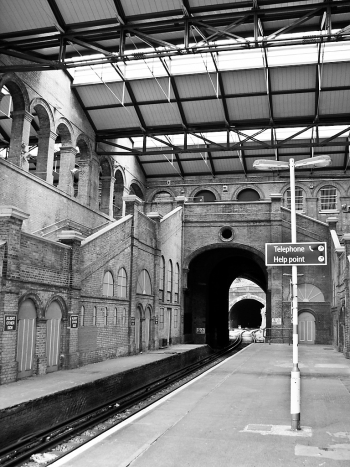Almost eight years ago, I dared to go to the end of the line. I was a new girl in Dalston’s Ridley Road, and the North London Line that lay at the end of the market, past the huge snails, the hung chicken heads and the snowy-white webs of tripe, kept daring me to go east for pleasure, rather than head west for work. So one day I turned right instead of left, and went to North Woolwich. As the train chugged through the pre-Olympic wastelands, I saw crumbling chimneys, shuttered squats, dizzy rainbows of car parts, and the small hints of the future that glittered between them. Stratford’s slick chrome was only a mid-point back then – a brief shimmer before the trudge through West Ham, Canning Town, Custom House, Silvertown – and not the iridescent ending we all know now. I remember the heat in my fingers as I wrote about the journey for the first issue of the magazine you now hold in your hands.
Dalston now is very different; a creature in the process of shedding its skin. But, in amongst all the cumbersome, alien developments littering Dalston Lane, a pristine station gleams where the old ska club used to be. And from here, following the course of tracks that closed in 1986 and then going on to join the old East London Line at Whitechapel, a new line surges, rather bravely, towards the dark, distant South. Eventually it will join the old North London Line too, burrowing under Kingsland High Street like a shiny pioneer, gliding its final five minutes to Highbury and Islington.
But for now it simply sits there, blinking at me brazenly. It reminds me of what has gone, but also offers fresh passage. One Saturday morning, it bites me, and my blood surges with poison. It is promising me Crystal Palace, promising me another world.
Dalston Junction glows silver and tangerine, like a Chocolate Orange. The platforms are wide, smooth and airy, not brown and bubblegum-pocked. I sit in one carriage, and realise that all the others are joined; that I could ride a bike from one end of this train to the other if I wanted. We pull away smoothly, and through the glass I see E8’s rear windows. I suddenly remember the days living nearby with Barry, the purple and yellow Silverlink trains shaking our papery walls, our tottery washing-up, our CDs stacked like Jenga blocks. As this train moves off with a soft whoosh, I leave all that behind; I think about how things move on, and about how much has changed.
A minute later, we reach Haggerston, and Stonebridge Gardens open up, a sea of mossy green full of roundabouts and see-saws. A blue concrete snake weaves through invisible waves, and the sun glints gently at me through the tower blocks. Between Hoxton and Shoreditch High Street, the city flutters its eyelashes, skyscrapers lining up in higgle-piggledy order, awaiting my scorecards. As they do, I catch my breath, and think about what these new tracks are doing. They make distances shrink and remodel the contours of our neighbourhoods; they bring people and places much closer together; they write new lines into London; they etch their grooves; leave their scars.
For a while, the London Overground channels into the earth, and I’d be pedantic if the experience wasn’t so heavenly. The cool steel feels warm here; the low lights mollycoddle me. Whitechapel station is even below the London Underground platforms, but it feels higher up, hardly buried and burrowing. We go under the Thames through Brunel’s famous tunnel and emerge, blinking into the light, at Surrey Quays. After the cool warehouses and open spaces, we join the Brighton main line at New Cross Gate, see the pubs and the houses nestling around us, other communities that once seemed so far away getting on with their day.
These are old tracks, brushed with weeds, dust and dirt, that have puttered through the ages quietly and happily. But to me, a North-East London girl by accident rather than design, they could have been laid yesterday. I look at my watch, and can’t believe it has been only twenty minutes since I made this deep cut between my past, my old home, and this present, this newness. We glide on through Brockley, Forest Hill, Honor Oak Park, Sydenham, and the names feel daring to my eyes, exotic to my tongue. I smile that even the leaves look greener on the other side, but I wonder if this is because they feel nearer now, more available, more mine.
As I approach Crystal Palace, the tall pylon I used to squint to see from Alexandra Park is no longer a knitting needle shimmering faintly in the distance. It is towering but friendly, welcoming me into its wires. The dinosaurs of Crystal Palace Park emerge from the undergrowth to the right, and I imagine them winking at me their strange, bulbous eyes.
This train terminates here.
I step onto the platform and take in the bulk of the station, the old stones, the curved ceiling, the steps that take me up. I think about North Woolwich again, but then
I think what happens next. In thirty five minutes, London has given me yet another adventure. It has given me so much. It has given me itself.


